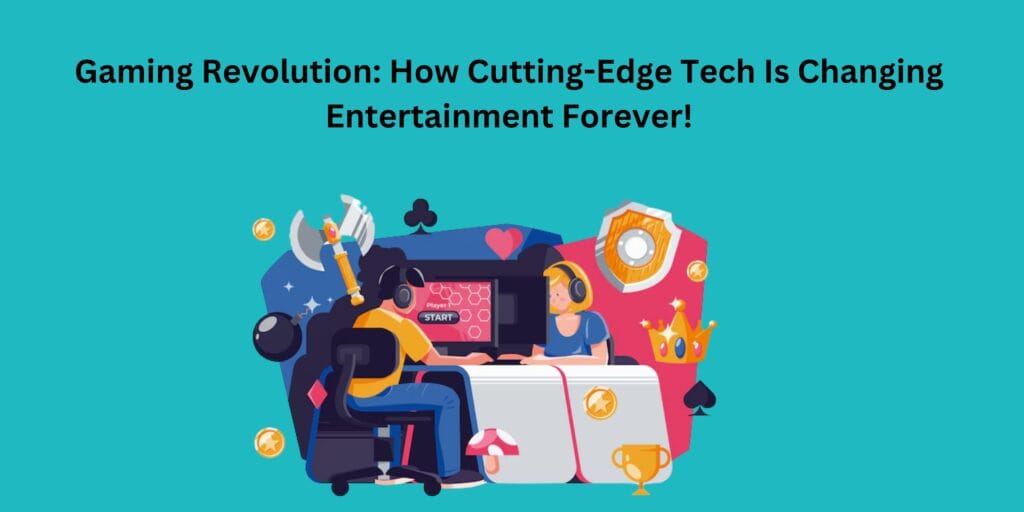Gaming has come a long way from the days of simple pixelated screens and repetitive sound effects. Today, a convergence of innovative technologies is revolutionizing the way we play, watch, and experience games. In this article, we’ll explore how advancements like artificial intelligence, virtual and augmented reality, cloud gaming, blockchain, and next-generation graphics are not only redefining gameplay but also transforming gaming into a dynamic cultural phenomenon. Whether you’re a casual gamer or a dedicated enthusiast, read on to see how the future of gaming is unfolding right before our eyes.

The Dawn of a New Era in Gaming
Over the past few decades, gaming has shifted from a niche hobby to a mainstream form of entertainment. This transformation is powered by a relentless drive for technological innovation. Each breakthrough has opened up new avenues for game design, storytelling, and user engagement. Let’s take a closer look at the technologies leading this revolution.
1. Artificial Intelligence: Making Games Smarter and More Adaptive
Artificial Intelligence (AI) is perhaps the most talked-about tool in modern game development. It’s not just about making enemies more challenging; AI now plays a crucial role in creating immersive and dynamic experiences.
How AI Elevates Gaming:
- Dynamic NPC Behavior: Gone are the days of predictable non-player characters (NPCs). Modern AI helps create characters that adapt to your gameplay, respond to your strategies, and even learn from your actions. For instance, in games like The Witcher 3, NPCs can exhibit a range of behaviors, making each interaction feel more realistic.
- Procedural Content Generation: AI can generate entire worlds on the fly. No Man’s Sky is a prime example, where AI algorithms create vast, explorable universes with unique planets, ecosystems, and weather patterns. This approach means that every player’s journey is distinct, contributing to endless replayability.
- Adaptive Difficulty: With AI tracking your progress and playstyle, games can adjust their difficulty in real-time. For example, in titles such as Left 4 Dead, the “AI Director” tweaks the game environment to maintain tension and balance, ensuring that the challenge is always just right.
Real-World Impact:
AI is not only transforming gameplay but also influencing esports and game testing. Developers use AI tools to analyze player behavior and optimize game balance, while coaches leverage AI to enhance team strategies. This dual application makes gaming more engaging and competitive.
Read more
2. Virtual Reality (VR) & Augmented Reality (AR): Stepping Into New Worlds
Imagine putting on a headset and stepping into an entirely new universe where you can interact with your surroundings as if they were real. VR and AR are making that possible, offering experiences that blur the line between reality and fantasy.
VR: A Fully Immersive Experience
- Hyper-Realistic Environments: With VR, games like Half-Life: Alyx transport players into immersive environments that engage all your senses. The feeling of being present in a virtual world can turn a typical gaming session into an unforgettable adventure.
- Physical Interaction: Modern VR systems come with motion tracking and haptic feedback, letting you physically interact with virtual objects. This kind of tactile feedback makes everything from combat to puzzle-solving feel more intuitive and lifelike.
AR: Blending the Virtual with the Real
- Real-World Integration: Augmented reality adds digital elements to the physical world. Pokémon GO is a perfect example, where players explore their neighborhoods to catch virtual creatures, fostering community engagement and outdoor activity.
- Enhanced Social Interaction: AR has the potential to bring people together in shared experiences. Imagine a multiplayer game where players see virtual characters interacting with the real world around them, sparking conversations and collaboration.
The Future of Immersive Tech:
Both VR and AR are evolving quickly. As devices become more affordable and user-friendly, these technologies will likely merge with everyday activities—from education and training to remote work and social networking—making the digital world more accessible and interactive.
3. Cloud Gaming: Freedom to Play Anywhere
Imagine being able to play your favorite game without needing a high-end console or a powerful computer. That’s the promise of cloud gaming. By streaming games over the internet, players can enjoy high-quality experiences on almost any device.
Benefits of Cloud Gaming:
- Device Independence: With platforms like NVIDIA GeForce Now and Xbox Cloud Gaming, your smartphone or tablet can become a gateway to console-quality gaming. This means you can play at home, on public transport, or even while traveling.
- Instant Access: Cloud gaming eliminates the need for lengthy downloads or expensive hardware upgrades. With a stable internet connection, games are available instantly, making gaming more accessible than ever.
- Seamless Integration: Imagine starting a game on your home PC and continuing on your mobile device without losing progress. Cloud gaming makes this level of flexibility possible, changing how we think about game ownership and portability.
Real-World Examples:
Google Stadia and PlayStation Now are two prominent names in the cloud gaming arena. Their services have paved the way for a future where the boundaries between different gaming platforms are increasingly blurred, creating a more connected and versatile gaming ecosystem.
4. Blockchain and NFTs: Redefining Digital Ownership
Blockchain technology is shaking up many industries, and gaming is no exception. By introducing Non-Fungible Tokens (NFTs), blockchain brings true digital ownership into the hands of players.
How Blockchain Is Changing Gaming:
- Play-to-Earn Models: Games like Axie Infinity have shown how players can earn real money through in-game achievements. By winning battles and trading NFTs, players convert digital success into tangible rewards.
- True Ownership: Traditional games often restrict you from selling or trading your in-game items. Blockchain-based games, however, empower you to own, trade, and even monetize your digital assets securely.
- Decentralized Economies: Blockchain ensures transparency and security in transactions. This means less risk of fraud and more trust in the virtual economies that power many online games.
Challenges and Considerations:
While blockchain gaming is full of potential, it comes with challenges such as market volatility, environmental concerns due to energy use, and regulatory hurdles. Developers and communities are actively working on solutions to make blockchain gaming more sustainable and user-friendly.
5. Hyper-Realistic Graphics: The Art of Creating Believable Worlds
Graphics have always played a crucial role in how we experience games. Today’s visual technologies are so advanced that some games offer experiences almost indistinguishable from reality.
Key Innovations in Graphics:
- Ray Tracing: This technique simulates realistic lighting by tracking the path of light rays, leading to stunning effects like lifelike shadows, reflections, and natural-looking environments. Games such as Cyberpunk 2077 and Minecraft RTX highlight how ray tracing can transform visual storytelling.
- Photorealistic Textures and Environments: With engines like Unreal Engine 5, developers can create environments with astonishing detail. Nanite technology allows for high-resolution assets to be rendered in real-time, making every leaf, building, and character look incredibly realistic.
- Advanced Motion Capture: Capturing real-life movements and facial expressions is key to creating believable characters. Games like The Last of Us Part II use sophisticated motion capture techniques to bring characters to life, making every interaction emotionally resonant.
Why Graphics Matter:
Stunning graphics not only enhance immersion but also contribute to storytelling. When every detail feels real, players become emotionally invested in the game world, leading to richer narratives and deeper experiences.
6. Social Gaming: Building Communities and Beyond
Gaming today is as much about community and connection as it is about the gameplay itself. Online multiplayer experiences have turned gaming into a social activity that brings people together from around the globe.
The Social Side of Gaming:
- Online Multiplayer Experiences: Games like Fortnite and Apex Legends offer dynamic, competitive environments where players team up and compete with others. These games create communities that extend far beyond the screen.
- Streaming and Esports: Platforms such as Twitch and YouTube have made it possible for gamers to share their experiences live with millions of viewers. This has not only given rise to esports but also created career opportunities in content creation, coaching, and commentary.
- Community-Driven Content: Many games now feature user-generated content and modding communities. These initiatives allow players to customize and enhance their gaming experiences, fostering creativity and collaboration.
The Broader Impact:
Gaming communities are not just about playing; they are spaces for learning, support, and social interaction. From charity streams to fan conventions, the social aspect of gaming has created vibrant ecosystems that contribute positively to culture and society.
7. The Future of Gaming: What’s Next?
The gaming landscape is continuously evolving, and the future holds even more exciting developments. As technology advances, several trends are likely to shape gaming in the coming years.
Upcoming Trends:
- Enhanced AI Integration: As AI technology becomes more sophisticated, expect even smarter NPCs, more responsive environments, and games that can adapt seamlessly to each player’s style.
- Expanded Use of VR/AR: With improvements in hardware and software, VR and AR will become more accessible and integrated into everyday activities. We might see virtual meeting spaces, educational simulations, and even social networks built around these immersive technologies.
- Growth in Cloud Gaming: With 5G networks and improved internet speeds on the horizon, cloud gaming will likely become the norm. This means even more seamless, high-quality gaming experiences without the need for expensive hardware.
- More Robust Blockchain Ecosystems: As developers and regulators work together to address the challenges of blockchain technology, expect more secure, user-friendly applications that offer true digital ownership and decentralized economies.
How Gamers Can Prepare:
- Stay Informed: Follow tech news and gaming forums to keep up with the latest trends. Knowledge is power when it comes to understanding new developments.
- Experiment and Adapt: Don’t be afraid to try new gaming platforms or technologies. The more you experiment, the more you’ll enjoy a rich and evolving gaming experience.
- Join the Conversation: Engage with other gamers online. Sharing experiences and insights can help you navigate the rapidly changing landscape of gaming technology.
FAQs
AI helps create smarter NPCs, procedural content generation, and adaptive gameplay, ensuring that each player has a unique and engaging experience. It also supports game testing and strategy analysis in competitive gaming.
VR (Virtual Reality) fully immerses you in a digital world using headsets and motion tracking, while AR (Augmented Reality) overlays digital elements onto your real-world environment. Both offer unique interactive experiences.
Cloud gaming has advanced rapidly. With improvements in internet speeds and 5G, services like NVIDIA GeForce Now and Xbox Cloud Gaming have become very reliable, although a stable internet connection is essential.
Blockchain introduces true ownership of digital assets through NFTs, enabling play-to-earn models and decentralized economies. It ensures transparency and security in transactions, although there are still challenges to overcome.
Conclusion: Embrace the Revolution
The world of gaming is undergoing an unprecedented transformation.
Artificial intelligence is making experiences smarter. Virtual and augmented reality are building immersive worlds. Cloud gaming offers unmatched flexibility. Blockchain is changing digital ownership. Hyper-realistic graphics ensure every detail matters. The future of entertainment shines brighter than ever.
For casual players and die-hard fans, these innovations are not just trends. They are a revolution reshaping our interactions with digital worlds. The gaming industry is no longer limited to one medium. It’s a vibrant ecosystem that spans many platforms and influences every part of modern life.
